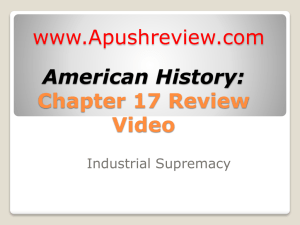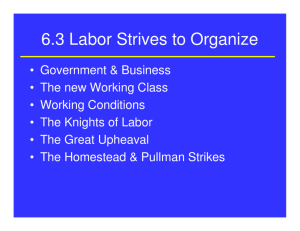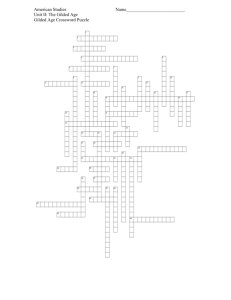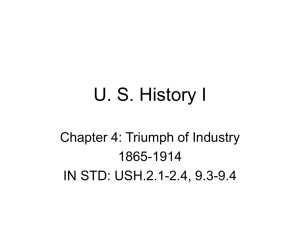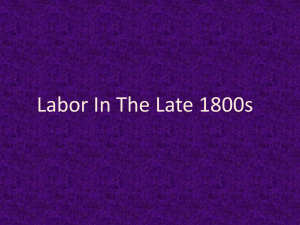Industrial Supremacy
advertisement
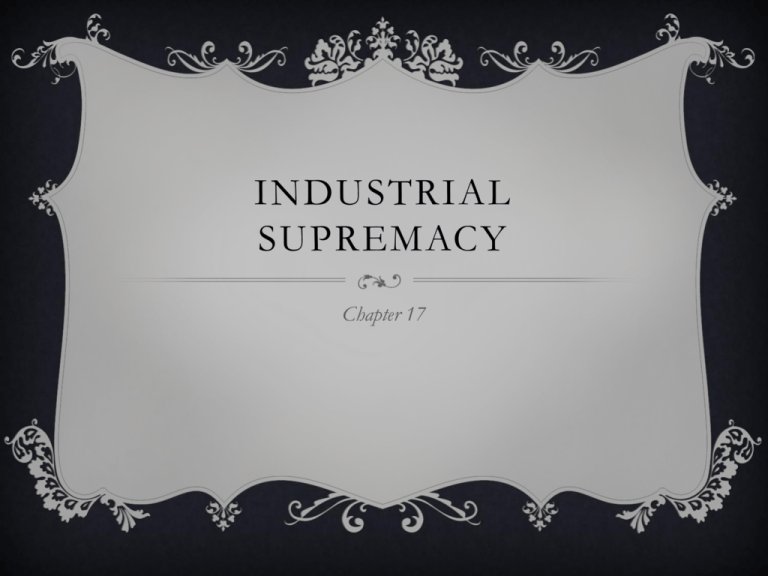
INDUSTRIAL SUPREMACY Chapter 17 TECHNOLOGY IMPROVES Technological advances before the war made the Industrial Revolution possible • Bessemer process (Henry Bessemer and William Kelly) converted iron to steel. • The process efficiently produced large quantities of steel • Pittsburgh, close to iron mines, became the center of steel production • Rapidly expanding railroads increased the demand for steel. INVENTIONS/DISCOVERIES Mechanized factories needed lubricants. Pennsylvanian George Bissell discovered that refined petroleum could be used for this as well as lamps and other purposes In 1859, his well in Titusville, Penn began pumping oil (Edwin Drake one of Bissell’s employees) By the 1870s, oil was America’s fourth largest export. INVENTIONS/DISCOVERIES In 1893, Charles and Frank Duryea developed the first gasoline driven motor vehicle in America. Three years later Henry Ford developed the Model T (1895‐ 4 cars; 1917‐ 5 mil cars) The Wright brothers invented an airplane in 1903, but it did not become a commercial proposition until the 1920s. WRIGHT BROTHERS TECHNOLOGY IMPROVES Rapid technological change inspired businesses to sponsor research General Electric, Bell Telephone, DuPont, and Eastman Kodak supported research labs in early 20th century. They also turned to universities to help make them more competitive. TECHNOLOGY IMPROVES As production techniques evolved, a new study following the principles by Frederick Winslow Taylor, called scientific management arose. He urged companies to specialize tasks in the production process to make workers more efficient and increase output. A Consequence of Taylor’s methods was an increase in management’s control over the workplace and reduced the need for highly skilled labor. HENRY FORD Henry Ford’s introduction of the moving assembly line (1914) and his automobile plant exemplified scientific management. • The production time for a Model T decreased from 12 ½ hours to 1 ½ hours • He reduced the hours and increased the wages of his workers • The price of the auto dropped from $950 in 1914 to $290 in 1929 FORD ASSEMBLY LINE RAILROADS Railroads underlay the industrial growth of America in the 19th century They provided demand for heavy goods and created a national market by connecting the country Chicago became the railway hub of the central U.S. Time zones were developed to make schedules easier to follow (In the last four decades of 19th century the miles of track increased six‐fold, which was spurred in part by government subsidies In 1860, 30,000 miles if track existed; In 1900, 193,000 miles of track existed. NEW FORMS OF BUSINESS New forms of business organizations worked to concentrate capital The modern corporation that developed could sell stock and offered limited liability to their shareholders Allowed businesses to raise the capital necessary to finance large business ventures Developed a class of managers who were often separate from ownership. This kind of business organization allowed consolidation and concentration in many industries. JOHN D. ROCKEFELLER John D. Rockefeller used horizontal integration to expand in the oil industry He initially acquired a substantial share of the nation’s refineries and ultimately controlled the entire industry He later expanded vertically by acquiring interests in all phases of the production of oil By 1880s he controlled access to 90% of the nation’s refined oil ANDREW CARNEGIE Andrew Carnegie used vertical integration to control all aspects of steel production from iron ore to sales of finished steel 1901, he sold his company to J.P. Morgan from the U.S. Steel Corporation (first billion‐dollar U.S.company) CAPTAINS OF INDUSTRY OR “ROBBER BARONS” These industrialists were firm believers in free enterprise, but whenever possible they tried to eliminate “cutthroat competition”. ELIMINATING COMPETITION Pools were informal agreements among companies to stabilize rates and divide markets, yet they were not often successful Trusts were an organization in which shareholders in individual corporations would exchange their shares of company stock for shares of a trust, which was much more successful. The trustees could exercise considerable control over an industry and distribute profits to the trust’s shareholders. A holding company was a variation in this business form ELIMINATING COMPETITION In 1889, New Jersey changed its laws of incorporation to permit companies to actually buy up other companies, which made trusts unnecessary & permitted actual corporate-mergers Rockefeller relocated Standard Oil to New Jersey & created a “holding company”. A central corporate body that would buy up stock of various members of the Standard Oil trust and establish direct formal ownership of the corporations in the trust. By 1900, 1% of America’s corporations controlled over 1/3 of the nation’s manufacturing output. This economic growth was controversial. CAPITALISM & IT’S CRITICS Rise of industrial capitalism and its effect spurred debate about the role of the individual n democracy Supporters argued that the system provided expanded opportunity to gain wealth and become a “self‐made man” Herbert Spencer’s theory of Social Darwinism provided justification that the fittest survived and that great fortunes were a result of natural rules. Yale’s William Graham Sumner supported this ideology by theorizing that individuals have the absolute freedom to compete and either succeed or fail. “ROBBER BARONS” Industrialists did everything possible to eliminate competition and replace it with individual power in the marketplace. They also used bribery and corruption to gain the government’s support for their industries. The idea of laissez faire, that government should not regulate or control business, was a prominent part of their philosophy. AN INDUSTRIALIST’S RESPONSIBILITY Andrew Carnegie outlined the responsibility of the wealthy in his 1889 book The Gospel of Wealth. He argued that wealth should return to the society from which it came & that industrialists should devote much of their fortunes to philanthropy (libraries, educational institutions, etc.). A Popular promoter of this idea was Horatio Alger who wrote rags‐to‐riches novels chronicling the rise from poverty to wealth. OPPONENTS OF INDUSTRY Others criticized a system that simultaneously promoted vast wealth and poverty. The Socialist Labor Party (led by Daniel De Leon) attracted a modest following of intellectuals and an offshoot became the more enduring American Socialist Party in 1901. In 1879 Henry George published Progress and Poverty, which questioned the dilemma of the American economic system. For him the issue was the increasing value of land and he proposed a single tax on land to destroy monopoly and redistribute wealth. LOOKING BACKWARD Looking Backward (utopian novel) by Edward Bellamy explored what happened when a man fell asleep in 1887 only to awaken in 2000, finding a world where poverty and corruption were unknown. A single government‐controlled trust distributed the nation’s production equally among all the people. QUESTIONING CAPITALISM Few Americans questioned the basic capitalistic tenants, but many were concerned about the growing power of monopoly on which they blamed high prices and economic instability. Severe economic panics in 1873 and 1893, the threat of concentrated economic power on the individual’s ability to advance, and the arrogance of the wealthy—which was publicly displayed in conspicuous consumption bred growing resentment and criticism of both the wealthy and of the system responsible for its creation. INDUSTRIAL WORKERS For workers, industrialism was a double-edged sword. They enjoyed a rise in their standard of living, but at the expense of long hours, low wages, and deteriorating conditions in the workplace. INDUSTRIAL WORKERS The workforce expanded dramatically. Rural workers left the farm and migrated to the city. Immigrants came to America from Europe, Asia, Mexico, and Canada. After the end of the Civil War, immigration shifted from northern Europe to southern and eastern Europe by the end of the century. In the West, immigrants came from Mexico and Asia until the Chinese Exclusion Act of 1882. Immigrants were drawn to America by prospects of opportunity & the desire to escape poverty and oppression. 25 million immigrants came to the U.S. between 1865‐1915 ELLIS ISLAND IMMIGRATION Industry recruited foreign labor and was supported by the Labor Contract Law, which was legislation that allowed businesses to pay in advance for the passage of workers (repealed in 1885) These workers often worked for low wages that inflamed ethnic tensions between foreign workers and American labor. INDUSTRIAL WORKERS Standard of living was rising. The average income was $400 to $500 a year (put most workers close to poverty). Industrial work imposed other hardships. Factory work was routine and impersonal during 10 hour days, 6 days a week The principles of scientific management lowered the need for skills and transferred control from workers to managers. This led to the increased number of women and children working in factories. WOMEN WORKERS From 1870 to 1900, the number of women in the industrial labor force quadrupled to 17% (20% of all women were wage earners) The textile industry was the largest employer of women (domestic work employed many others) CHILDREN More than 1.7 million children under 16 worked in factories or on farms in 1900. Many families could not survive without the additional income that women and children earned. These groups was vulnerable to exploitation, which resulted in child‐labor laws, but initially most were ineffective, unenforceable, or both. For all workers, conditions in the workplace were dangerous & few employers made efforts to improve the situation. CHILD LABOR RESPONSE TO HARSH WORKING CONDITIONS The workers response to these problems mirrored their employers. They attempted to form combinations in a search for control. Craft unions had existed since the early republic, but were local and could not exert control in the national economy. The first attempt was the National Labor Union organized in 1866. Reform‐oriented and with little direct connection to labor, it disintegrated after the Panic of 1873. MOLLY MAGUIRES A more radical and violent group was the Molly Maguires in the anthracite coal region of Pennsylvania. Their terror tactics were used by mine owners to turn public opinion against the union. THE GREAT RAILROAD STRIKE The Great Railroad Strike of 1877 was started by the announcement of a 10 percent wage cut. Strikers stopped rail service, destroyed equipment, and rioted in several cities. President Rutherford B. Hayes ordered federal troops to restore order in West Virginia. State militias were called out. This event illustrated the widespread nature of labor issues, deep resentment of labor toward employers, and weakness of the labor movement demonstrated by the strike’s failure. KNIGHTS OF LABOR The first significant labor union was the Knights of Labor (1869). The union was open to all workers including women and African Americans. The loose organization and reform platform (8 hour work day, the abolition of child labor, reform of the capitalist system) was moderate Terrence V. Powderly led the union in the 1870s & membership topped 700,000 in 1886. By 1890, it had shrunk to 100,000. POWDERLY “BEST MUSTACHE EVER” AMERICAN FEDERATION OF LABOR Another rival and more successful union developed known as the American Federation of Labor (AFL). It joined together craft unions of skilled labor, but did not allow women. It only saw women as competitors to male workers. The AFL pushed for equal wages for men and women. They accepted capitalism & wanted a greater share of its rewards for workers There goals included better wages; shorter hours, & better working conditions. They preferred collective bargaining, but were ready to strike when necessary. The AFL called for a general strike on May 1, 1886 if a national 8 hour day was not achieved. HAYMARKET SQUARE RIOT Resulted in a protest in Chicago’s Haymarket Square (where a strike against the McCormick Harvester Company was already underway). Someone threw a bomb at the policemen there killing 7. The police opened fire killing 4 more. Eight anarchists were convicted of murder on the basis that their statements had incited the bomb thrower. ANARCHISM Anarchism became the new threat to social order and private property & was linked to labor movement. This proved to be the demise of the Knights of Labor and provided an obstacle to labor unions in America. Violent strikes in the 1890s fueled anti‐labor sentiment. HOMESTEAD STRIKE In 1892 after wages were cut, the union at Andrew Carnegie’s Homestead Plant struck The Plant’s manager and Carnegie’s chief aide, Henry Clay Frick, locked out the workers and hired Pinkerton Agents to protect the strikebreakers that Frick planned to hire. The agents surrendered and were ejected from the town The company asked the National Guard to protect its property & steel production at the plant resumed with strikebreakers When an attempt to assassinate Frick failed, public opinion turned against the union and the union was broken. HOMESTEAD STRIKE PULLMAN STRIKE Another important strike occurred at Pullman Palace Car Company near Chicago in 1894. George Pullman had built a “model” town that he rented to his workers In the winter of 1893‐1894, Pullman cut wages 25% but refused to lower rents in company housing. Workers struck & were supported by American Railway Union (headed by Eugene V. Debs) The Union refused to run trains hauling Pullman Cars and equipment. PULLMAN STRIKE Thousands of railway workers struck and rail transportation west of Chicago was paralyzed Railroad owners appealed to the federal government. President Grover Cleveland sent 2,000 troops to Chicago A federal court issued an injunction against the union. Debs defied it & was arrested. The strike was dissolved. EARLY RESULTS Unions represented only a small proportion of national labor force (only 4%) & often excluded unskilled workers, women, African Americans, and recent immigrants. Women attempted to form a union in 1903 known as the women’s Trade Union League that was unsuccessful. Ethnic tensions made it difficult to organize. Gains for workers were few as wages increased very little Legislation of an 8 hour work day on government projects and for government employees affected few workers. Labor organization could not match the strength of corporations.
